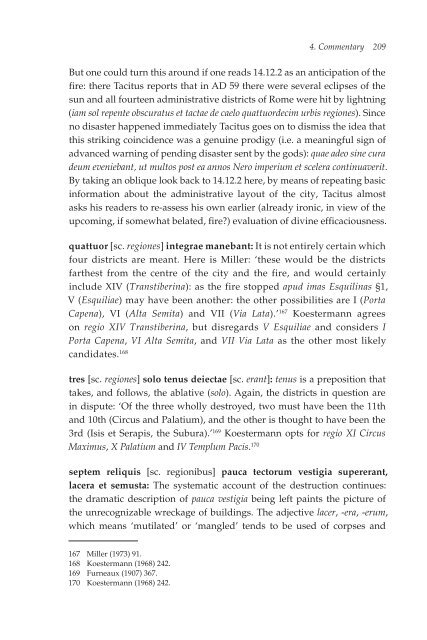Tacitus, Annals, 15.20-23, 33-45. Latin Text, Study Aids with Vocabulary, and Commentary, 2013a
Tacitus, Annals, 15.20-23, 33-45. Latin Text, Study Aids with Vocabulary, and Commentary, 2013a
Tacitus, Annals, 15.20-23, 33-45. Latin Text, Study Aids with Vocabulary, and Commentary, 2013a
Create successful ePaper yourself
Turn your PDF publications into a flip-book with our unique Google optimized e-Paper software.
But one could turn this around if one reads 14.12.2 as an anticipation of the<br />
fire: there <strong>Tacitus</strong> reports that in AD 59 there were several eclipses of the<br />
sun <strong>and</strong> all fourteen administrative districts of Rome were hit by lightning<br />
(iam sol repente obscuratus et tactae de caelo quattuordecim urbis regiones). Since<br />
no disaster happened immediately <strong>Tacitus</strong> goes on to dismiss the idea that<br />
this striking coincidence was a genuine prodigy (i.e. a meaningful sign of<br />
advanced warning of pending disaster sent by the gods): quae adeo sine cura<br />
deum eveniebant, ut multos post ea annos Nero imperium et scelera continuaverit.<br />
By taking an oblique look back to 14.12.2 here, by means of repeating basic<br />
information about the administrative layout of the city, <strong>Tacitus</strong> almost<br />
asks his readers to re-assess his own earlier (already ironic, in view of the<br />
upcoming, if somewhat belated, fire?) evaluation of divine efficaciousness.<br />
quattuor [sc. regiones] It is not entirely certain which<br />
four districts are meant. Here is Miller: ‘these would be the districts<br />
farthest from the centre of the city <strong>and</strong> the fire, <strong>and</strong> would certainly<br />
include XIV (Transtiberina): as the fire stopped apud imas Esquilinas §1,<br />
V (Esquiliae) may have been another: the other possibilities are I (Porta<br />
Capena), VI (Alta Semita) <strong>and</strong> VII (Via Lata).’ 167 Koestermann agrees<br />
on regio XIV Transtiberina, but disregards V Esquiliae <strong>and</strong> considers I<br />
Porta Capena, VI Alta Semita, <strong>and</strong> VII Via Lata as the other most likely<br />
c<strong>and</strong>idates. 168<br />
tres [sc. regiones] solo tenus deiectae [sc. erant]tenus is a preposition that<br />
takes, <strong>and</strong> follows, the ablative (solo). Again, the districts in question are<br />
in dispute: ‘Of the three wholly destroyed, two must have been the 11th<br />
<strong>and</strong> 10th (Circus <strong>and</strong> Palatium), <strong>and</strong> the other is thought to have been the<br />
3rd (Isis et Serapis, the Subura).’ 169 Koestermann opts for regio XI Circus<br />
Maximus, X Palatium <strong>and</strong> IV Templum Pacis. 170<br />
septem reliquis [sc. regionibus] pauca tectorum vestigia supererant,<br />
The systematic account of the destruction continues:<br />
the dramatic description of pauca vestigia being left paints the picture of<br />
the unrecognizable wreckage of buildings. The adjective lacer, -era, -erum,<br />
which means ‘mutilated’ or ‘mangled’ tends to be used of corpses <strong>and</strong><br />
167 Miller (1973) 91.<br />
168 Koestermann (1968) 242.<br />
169 Furneaux (1907) 367.<br />
170 Koestermann (1968) 242.


















